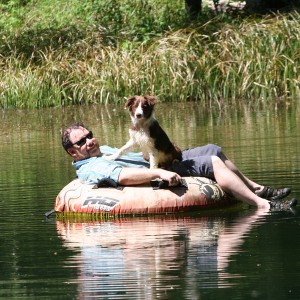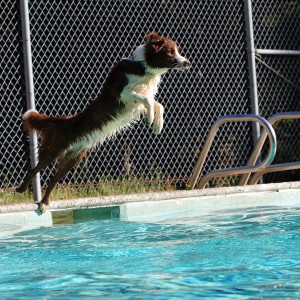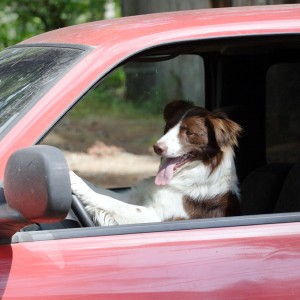Sometimes in training we seek not only to teach a new behavior, but also to modify an animal’s mental state. Often this can be achieved simply by choosing to reward the animal only when it is in the desired state–reward when the dog is working calmly, or when the dog is happy and enthusiastic. This is one significant difference between advanced dog training and novice dog training: beginners think in terms of teaching a behavior, advanced trainers think in terms of shaping attitudes. It is straightforward to train a dog to walk at your left side, the elegance lies in training a dog to do so with enthusiasm and joy.
to train a dog to walk at your left side, the elegance lies in training a dog to do so with enthusiasm and joy.
I still remember how badly I messed this up with my first trained dog, many years ago-Tillie was an exuberant Newfoundland, and I was an easily embarrassed teenager. On our first night in obedience class, Tillie seemed to me to be the least-well-behaved puppy there, barking and dragging me around, and I resolved not to look like a fool the next week. So before the next class I took her on a huge hike: we climbed mountains and swam rivers and ran in sand and chased balls, and by the time we went to class she was happily exhausted. She calmly walked behind me at a glacial pace, and I felt that we had made great progress. For the next 10 weeks, every Thursday I repeated this routine, and never again was Tillie hyper in obedience class… A year later I decided it was time to try our hands at competition obedience, so I entered another class, and discovered that my bright, energetic, happy dog turned into a slug the moment I started doing obedience. She lagged behind, and did everything slowly and without any enthusiasm. It took me a while to realize that I had trained her to be that way… I had actually conditioned her psyche to enter into a particular state whenever certain cues were presented.
One particular situation where training mental state can be extremely beneficial is with a dog who gets too stimulated. Whether it is when another dog approaches, or during play, or when the doorbell rings-if your dog reacts with excess energy, you face the challenge of not only modifying the behavior, but also modifying the underlying excitation. One of the best techniques for this is training your dog to “cap” its own emotional response with an incompatible behavior before an undesired outcome. This morning, one of my dogs did a lovely job of illustrating that principle, and I thought I would share it:
Sequel is a young border collie rescue. He is very intelligent, but even more than most border collies, he has some behavioral quirks. Primarily they all center on a tendency to become over-stimulated rather easily. That tendency is present in his littermates, and is quite extreme, despite considerable work on reducing both the underlying causes and the specific manifestations. He sleeps right next to me in bed, and while he is an excellent sleeper, he tends to wake with much exuberance when the alarm goes off, which leads to his jumping on my head and then escalating frantic and annoying behaviors until I get up and take him outside to play. (I on the other hand wake grudgingly, and try desperately to hide under the covers.)
Knowing that one day while half asleep I might fling Sequel out the window, I decided that I should find a remedy. Given that I would be largely asleep, the solution needed to be fairly simple. So I put a large fabric crate in the room with the door permanently open and a comfy bed inside, and every morning when he jumped on my head I sent him into the crate and told him to wait there. I then waited for him to settle back down, and once he was relaxed I got up and took him outside.

He easily and effectively learned this, and for 6 months we had this routine-he sleeps soundly until the first noise, then wakes, gets excited, gets sent to lie in his crate, we both snooze for 10 minutes, then we get up.
Today, the phone rang early, and Sequel stood up, looked at me, stretched, hopped off the bed, went into the crate, and lay down and immediately went back to sleep while I talked on the phone.
On first blush this seems trivial-big deal, the dog learned to go into a crate. But look more closely. What is interesting about this is not that Sequel learned to go into a crate-he learned that perfectly within a day or two and did it reliably every morning. It is not even that he learned to go into the crate without my telling him. What changed this morning was that he stretched, did the behavior, and went back to sleep. He never got excited! An autonomic response changed. He would normally have had a surge of endorphins at that point, and would have sprinted into his crate and obediently waited. What was different was not that he did what I wanted, he always did what I wanted, it was that his nervous system actually skipped the excitation phase of the process. The crate behavior was an operantly conditioned, trained, behavior, but through enough repetitions, Sequel became classically conditioned to have a different emotional response.


Thanks for sharing! Great example of something that sounds a bit too theoretical when explained to people.